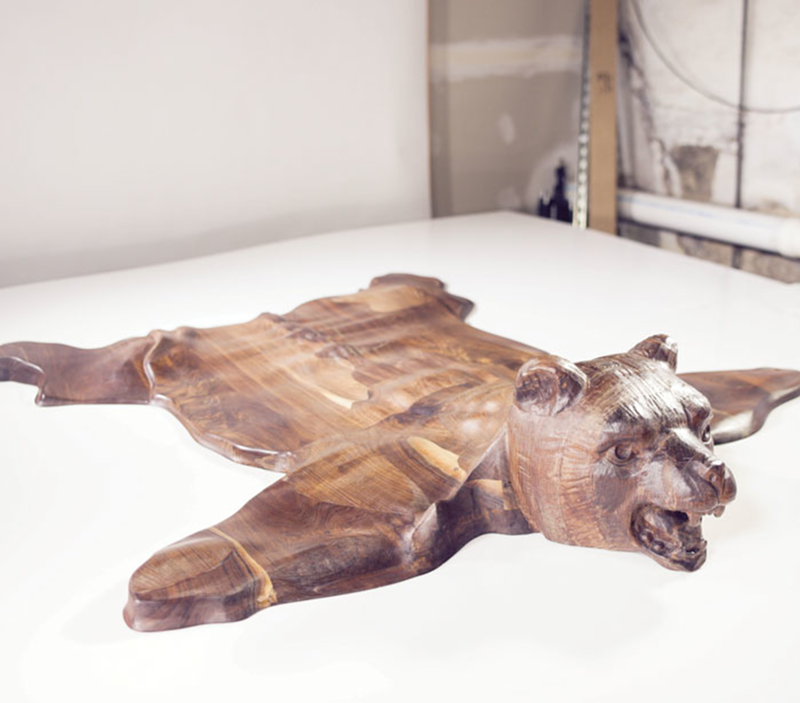At The Carnegie’s Modern Living: Objects and Context, curators Matt Distel and BLDG present two types of environments for considering artists’ household-inspired sculptures and design firms’ tables, lamps and more. The exhibition explores where the definitions of design and art merge and diverge. Can something functional also have aesthetic value? Should an object intended as sculpture be put into everyday use?
On opening night Dec. 4, it wasn’t long before visitors gravitated from thoughtfully viewing pieces in a museum-like setting on the first floor to lounging in an upper gallery that’s been reimagined as a patio in Los Angeles. Similar objects fill both rooms, but the furnishings take on new purpose upstairs, where teams of design firms and artists created three living spaces for their objects. In the “backyard,” a simulated bedroom and a dining room, the show’s vibe changes from looking to living.
Distel, The Carnegie’s exhibitions director, said Modern Living was inspired by the new restaurants and businesses in Northern Kentucky, downtown and Over-the-Rhine. “I felt I’d been seeing a lot of stuff by designers that looked like art, and art that looked like furniture,” he said.
Distel contacted Covington design firm BLDG to tap into the region’s sudden population of design-build studios. It rounded up the businesses Ampersand, Brush Factory, CVG Made, Grainwell and Such + Such. Distel called Cincinnati artists Keith Benjamin, Colin Klimesh, Matt Lynch, Matthew Metzger and Chris Vorhees, plus Taryn Cassella of Indianapolis.
My own concern was that this exhibit wouldn’t feel much different from walking through a modern furnishings store. But the curators and participants avoided that by mixing high-end and humor.
In the main gallery, Distel has placed both the fine and funky on pedestals for careful examination. The “Tower” cushion that Benjamin fashioned out of jeans and cereal boxes receives as much reverence as a maple table from CVG Made. The presentation is reminiscent of the Cincinnati Wing at the Art Museum. Vorhees’ transformation of thrift-store dressers — he hand-cut their previously flat tops into sleek slopes — recalls the city’s history of art-carved furniture. Ampersand’s aluminum “punk soap dishes” are as colorful as Rookwood’s tiles.
Before the exhibit turns too scholarly, Lynch’s not-quite-leaning tower of pizza boxes points to the fun possibilities when art and design unite as they do upstairs. Titled “LACKtose Tolerant” after the Ikea LACK table that’s the base, Lynch’s sculpture mimics a spike for office receipts.
At the patio party, Lynch both skewers and salutes modern design. “Faux Rest” is a log bench that Lynch crafted from Formica as skillfully as teammate Such + Such coaxes shapes out of natural wood. The whole garden scene is simultaneously real and plastic — this is supposed to be L.A., after all — as Klimesh’s ceramic bowls and Ampersand’s pink steel flamingos come off the exhibition shelves and pedestals and into play on the gallery’s artificial lawn.
In the bedroom space, Cassella’s work serves as what Distel called a pivot for the exhibition. She and Metzger both made furniture with acrylic and wood, but with “totally different aim and ambition,” to quote Distel. Cassella’s chair, which is paired with a concrete footrest, is built with particleboard. Metzger’s low table is made with fine walnut. What is sculpture — and what is functional — design? Cassella’s room divider built out of reclaimed Mylar, Masonite and metal screen provides the same privacy as CVG Made’s partition crafted from wood. But Cassella’s is art, and CVG Made’s is a work of art.
Style and silliness meet again in the dining room. Next to Brush Factory’s oak and walnut tables sit stools that Benjamin made from five-gallon buckets and denim-covered cushions. The juxtaposition is the same as in an actual house, where life takes over and the dining room is used less for formal meals and more for homework. We love pretty and artsy things, but in the right context. Modern living doesn’t mean living in a museum.
MODERN LIVING: OBJECTS AND CONTEXT continues through Feb. 6 at The Carnegie in Covington. More info: thecarnegie.com.






